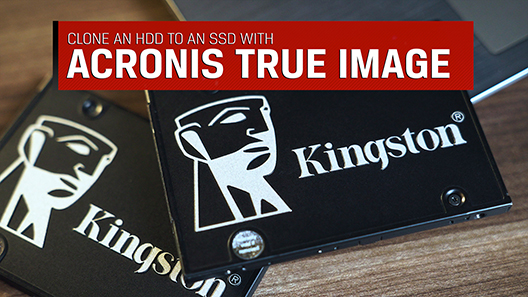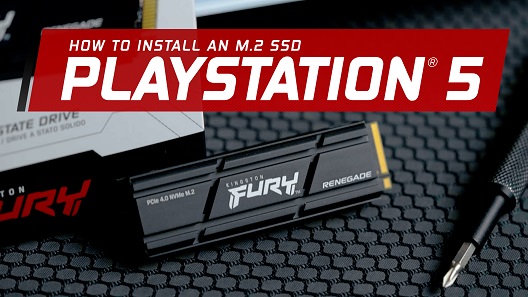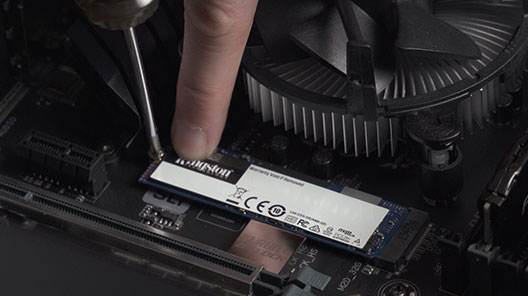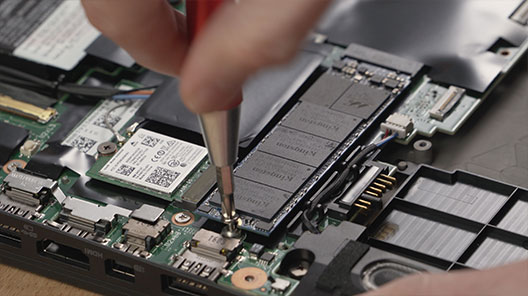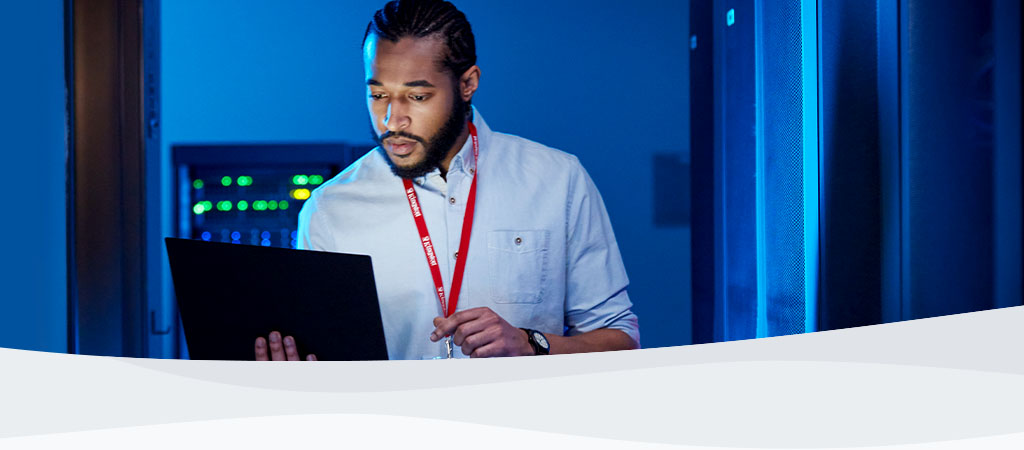
Kingston FURY Renegade PCIe 4.0 NVMe M.2 SSD - Soporte
Recursos
Videos
Preguntas más frecuentes
FAQ: KSD-200100-FURY-001
¿Fue útil?
1. Descarga Kingston SSD Manager de https://www.kingston.com/support/technical/ssdmanager para confirmar si hay una actualización de firmware disponible para tu unidad y, de ser así, aplica la actualización (si se recomienda).
2. Consulta la página de soporte del fabricante de tu sistema para confirmar si hay una actualización del BIOS disponible para tu sistema.
3. Confirma que estás ejecutando la última versión de tu sistema operativo y asegúrate de que no tienes ninguna actualización pendiente.
4. Confirma que estás ejecutando los últimos controladores de tu sistema. Para ello, visita la página de soporte del fabricante del sistema y busca las últimas actualizaciones de los controladores.
Si sigues teniendo problemas con tu sistema después de estos pasos, ponte en contacto con el soporte técnico de Kingston.
FAQ: KSD-012010-001-21
¿Fue útil?
Esto es común para el almacenamiento flash, ya sea SSD interno o almacenamiento USB externo, y se debe en parte a una variación en la forma de calcular el megabyte entre los fabricantes de memorias flash y los de discos duros de plato giratorio. Los fabricantes de discos duros calculan un megabyte (o 1.000x1.000 bytes) como 1.000KBs, mientras que el cálculo binario para el almacenamiento basado en flash es de 1.024KBs.
Ejemplo : Para un dispositivo de almacenamiento flash de 1TB, Windows calculará que tiene una capacidad de 931,32GB. (1,000,000,000,000÷1,024÷1,024÷1,024=931.32GB).
Además, Kingston se reserva parte de la capacidad mencionada para formatear y otras funciones, como el firmware y/o la información específica del controlador, por lo tanto, parte de la capacidad mencionada no está disponible para el almacenamiento de datos.
FAQ: KDT-010611-GEN-06
¿Fue útil?
FAQ: KSD-001525-001-00
¿Fue útil?
FAQ: KSD-012010-001-18
¿Fue útil?
FAQ: KSD-012010-001-00
¿Fue útil?
FAQ: KSD-012010-001-01
¿Fue útil?
Si esto no es posible, o si clonaste previamente tus datos antiguos en tu nueva unidad, confirma que la nueva unidad aparezca como un dispositivo de arranque en el BIOS del sistema, luego selecciónalo para arrancar.
FAQ: KSD-012010-001-03
¿Fue útil?
-Confirma que el BIOS del sistema reconoce tu nuevo SSD y, de lo contrario, visita el sitio web del fabricante de la placa madre o sistema para ver si hay un nuevo BIOS disponible.
-Verifica que los ajustes de tu BIOS estén configurados para aceptar un nuevo SSD NVMe.
-Confirma que tu sistema operativo de destino es compatible con SSDs NVMe (por ejemplo: Windows 8 o posterior)
Nota: Los SSDs de Kingston no requieren controladores adicionales para funcionar.
FAQ: KSD-012010-001-05
¿Fue útil?
https://support.microsoft.com/en-us/topic/update-to-add-native-driver-support-in-nvm-express-in-windows-7-and-windows-server-2008-r2-03cd423b-d42e-66c2-722b-019d16455a6b
FAQ: KSD-012010-001-06
¿Fue útil?
FAQ: KSD-012010-001-07
¿Fue útil?
Si la unidad está presente en el BIOS, es posible que debas inicializar el disco dentro del sistema operativo.
Para Windows:
Paso 1: Confirma que la unidad esté correctamente conectada y enciende el sistema, luego arranca en el sistema operativo Windows.
Paso 2: Presiona Windows + X y elije Administración de discos.
Paso 3: Si el SSD es nuevo y no está inicializado, aparecerá una ventana emergente que dice "Inicializar disco".
Paso 4: Elegir entre:
MBR (Master Boot Record o Registro Maestro de Arranque): Adecuado para unidades de menos de 2TB y sistemas más antiguos.
GPT (GUID Partition Table o Tabla de particiones GUID): Recomendado para sistemas y unidades modernos de más de 2TB.
Paso 5: Para cerrar la ventana, haz clic en Aceptar.
Paso 6: Una vez inicializado, verás el SSD como "No asignado". Haz clic derecho en él y selecciona Nuevo volumen simple.
Paso 7: Sigue las indicaciones en pantalla para formatear y asignar una letra de unidad al SSD.
Para Mac OS:
Paso 1: Confirma que la unidad esté correctamente conectada y enciende el sistema, luego inicia Mac OS.
Paso 2: Abre la Utilidad de Discos (puedes encontrarla usando Spotlight con Cmd + espacio y luego escribiendo "Utilidad de Discos").
Paso 3: En el panel izquierdo, selecciona tu SSD.
Paso 4: Haz clic en Borrar.
Paso 5: Proporcione un nombre para la unidad y, en Formato, elije:
APFS (Sistema de archivos de Apple) para Macs y SSDs más nuevos.
Mac OS Extended (con registro) para sistemas antiguos o HDDs.
Paso 6: Haz clic en Borrar. Una vez finalizado el proceso, el SSD estará listo para su uso.
Para Linux:
Paso 1: Confirma que la unidad esté correctamente conectada y enciende el sistema, luego inicia el sistema operativo Linux.
Paso 2: Abre una terminal.
Paso 3: Introduzca sudo fdisk -l para enumerar todas las unidades conectadas. Identifica tu SSD por su tamaño y anota el nombre del dispositivo, por ejemplo, /dev/sdb.
Paso 4: Inicializar el SSD utilizando fdisk o Parted. Aquí hay una guía básica sobre el uso de fdisk:
Escribe sudo fdisk /dev/sdb (reemplaza /dev/sdb con el nombre de tu dispositivo SSD).
Presiona g para crear una nueva tabla de particiones GPT.
Presiona n para crear una partición nueva. Sigue las instrucciones para especificar el tamaño y el tipo.
Presiona w para escribir los cambios.
Paso 5: Formatea la nueva partición en el SSD (por ejemplo, /dev/sdb1). Puedes formatearlo con el sistema de archivos que elijas:
Para ext4: sudo mkfs.ext4 /dev/sdb1
Para ext3: sudo mkfs.ext3 /dev/sdb1
Para FAT32: sudo mkfs.vfat /dev/sdb1
Paso 6: Montar el SSD:
Crea un punto de montaje: sudo mkdir /mnt/myssd
Monta el SSD: sudo mount /dev/sdb1 /mnt/myssd
Recuerda reemplazar /dev/sdb1 con el nombre de la partición de tu SSD.
FAQ: KSD-012010-001-15
¿Fue útil?
https://www.kingston.com/blog/pc-performance/two-types-m2-vs-ssd
FAQ: KSD-012010-001-16
¿Fue útil?
FAQ: KSD-200100-FURY-001
¿Fue útil?
Si tu SSD requiere un nuevo firmware, recibirás una notificación cuando ejecutes el software Kingston SSD Manager, que se encuentra aquí: www.kingston.com/ssdmanager
FAQ: KSD-012010-001-11
¿Fue útil?
M.2 es el factor de forma física. SATA y PCIe se refieren a la interfaz de almacenamiento; la principal diferencia es el rendimiento y el protocolo (lenguaje) que habla el SSD M.2.
La especificación M.2 ha sido diseñada para dar cabida a la vez a interfaces PCIe y SATA para SSDs. Los SSDs SATA M.2 utilizarán el mismo controlador que se encuentra actualmente en un SSD SATA típica de 2.5 ". Los SSDs M.2 PCIe utilizarán un controlador diseñado específicamente para ser compatible con el protocolo PCIe. Un SSD M.2 sólo puede admitir un protocolo, pero algunos sistemas tienen ranuras M.2 que pueden prestar soporte tanto a SATA como a PCIe.
FAQ: KSD-004005-001-00
¿Fue útil?
https://www.kingston.com/blog/pc-performance/nvme-vs-sata
FAQ: KSD-012010-001-19
¿Fue útil?
FAQ: KSD-012010-001-04
¿Fue útil?
Si tu SSD requiere un nuevo firmware, recibirás una notificación cuando ejecutes el software Kingston SSD Manager, que se encuentra aquí: www.kingston.com/ssdmanager
FAQ: KSD-012010-001-11
¿Fue útil?
FAQ: KSD-012010-001-12
¿Fue útil?
FAQ: KSD-012010-001-13
¿Fue útil?
FAQ: KSD-012010-001-14
¿Fue útil?
FAQ: KSD-012010-001-04
¿Fue útil?
-Confirma que el BIOS del sistema reconoce tu nuevo SSD y, de lo contrario, visita el sitio web del fabricante de la placa madre o sistema para ver si hay un nuevo BIOS disponible.
-Verifica que los ajustes de tu BIOS estén configurados para aceptar un nuevo SSD NVMe.
-Confirma que tu sistema operativo de destino es compatible con SSDs NVMe (por ejemplo: Windows 8 o posterior)
Nota: Los SSDs de Kingston no requieren controladores adicionales para funcionar.
FAQ: KSD-012010-001-05
¿Fue útil?
https://www.kingston.com/blog/pc-performance/two-types-m2-vs-ssd
FAQ: KSD-012010-001-16
¿Fue útil?
Si la unidad está presente en el BIOS, es posible que debas inicializar el disco dentro del sistema operativo.
Para Windows:
Paso 1: Confirma que la unidad esté correctamente conectada y enciende el sistema, luego arranca en el sistema operativo Windows.
Paso 2: Presiona Windows + X y elije Administración de discos.
Paso 3: Si el SSD es nuevo y no está inicializado, aparecerá una ventana emergente que dice "Inicializar disco".
Paso 4: Elegir entre:
MBR (Master Boot Record o Registro Maestro de Arranque): Adecuado para unidades de menos de 2TB y sistemas más antiguos.
GPT (GUID Partition Table o Tabla de particiones GUID): Recomendado para sistemas y unidades modernos de más de 2TB.
Paso 5: Para cerrar la ventana, haz clic en Aceptar.
Paso 6: Una vez inicializado, verás el SSD como "No asignado". Haz clic derecho en él y selecciona Nuevo volumen simple.
Paso 7: Sigue las indicaciones en pantalla para formatear y asignar una letra de unidad al SSD.
Para Mac OS:
Paso 1: Confirma que la unidad esté correctamente conectada y enciende el sistema, luego inicia Mac OS.
Paso 2: Abre la Utilidad de Discos (puedes encontrarla usando Spotlight con Cmd + espacio y luego escribiendo "Utilidad de Discos").
Paso 3: En el panel izquierdo, selecciona tu SSD.
Paso 4: Haz clic en Borrar.
Paso 5: Proporcione un nombre para la unidad y, en Formato, elije:
APFS (Sistema de archivos de Apple) para Macs y SSDs más nuevos.
Mac OS Extended (con registro) para sistemas antiguos o HDDs.
Paso 6: Haz clic en Borrar. Una vez finalizado el proceso, el SSD estará listo para su uso.
Para Linux:
Paso 1: Confirma que la unidad esté correctamente conectada y enciende el sistema, luego inicia el sistema operativo Linux.
Paso 2: Abre una terminal.
Paso 3: Introduzca sudo fdisk -l para enumerar todas las unidades conectadas. Identifica tu SSD por su tamaño y anota el nombre del dispositivo, por ejemplo, /dev/sdb.
Paso 4: Inicializar el SSD utilizando fdisk o Parted. Aquí hay una guía básica sobre el uso de fdisk:
Escribe sudo fdisk /dev/sdb (reemplaza /dev/sdb con el nombre de tu dispositivo SSD).
Presiona g para crear una nueva tabla de particiones GPT.
Presiona n para crear una partición nueva. Sigue las instrucciones para especificar el tamaño y el tipo.
Presiona w para escribir los cambios.
Paso 5: Formatea la nueva partición en el SSD (por ejemplo, /dev/sdb1). Puedes formatearlo con el sistema de archivos que elijas:
Para ext4: sudo mkfs.ext4 /dev/sdb1
Para ext3: sudo mkfs.ext3 /dev/sdb1
Para FAT32: sudo mkfs.vfat /dev/sdb1
Paso 6: Montar el SSD:
Crea un punto de montaje: sudo mkdir /mnt/myssd
Monta el SSD: sudo mount /dev/sdb1 /mnt/myssd
Recuerda reemplazar /dev/sdb1 con el nombre de la partición de tu SSD.
FAQ: KSD-012010-001-15
¿Fue útil?
FAQ: KSD-012010-001-18
¿Fue útil?
FAQ: KSD-012010-001-04
¿Fue útil?
FAQ: KSD-012010-001-00
¿Fue útil?
-Confirma que el BIOS del sistema reconoce tu nuevo SSD y, de lo contrario, visita el sitio web del fabricante de la placa madre o sistema para ver si hay un nuevo BIOS disponible.
-Verifica que los ajustes de tu BIOS estén configurados para aceptar un nuevo SSD NVMe.
-Confirma que tu sistema operativo de destino es compatible con SSDs NVMe (por ejemplo: Windows 8 o posterior)
Nota: Los SSDs de Kingston no requieren controladores adicionales para funcionar.
FAQ: KSD-012010-001-05
¿Fue útil?
Si esto no es posible, o si clonaste previamente tus datos antiguos en tu nueva unidad, confirma que la nueva unidad aparezca como un dispositivo de arranque en el BIOS del sistema, luego selecciónalo para arrancar.
FAQ: KSD-012010-001-03
¿Fue útil?
FAQ: KSD-012010-001-01
¿Fue útil?
Si la unidad está presente en el BIOS, es posible que debas inicializar el disco dentro del sistema operativo.
Para Windows:
Paso 1: Confirma que la unidad esté correctamente conectada y enciende el sistema, luego arranca en el sistema operativo Windows.
Paso 2: Presiona Windows + X y elije Administración de discos.
Paso 3: Si el SSD es nuevo y no está inicializado, aparecerá una ventana emergente que dice "Inicializar disco".
Paso 4: Elegir entre:
MBR (Master Boot Record o Registro Maestro de Arranque): Adecuado para unidades de menos de 2TB y sistemas más antiguos.
GPT (GUID Partition Table o Tabla de particiones GUID): Recomendado para sistemas y unidades modernos de más de 2TB.
Paso 5: Para cerrar la ventana, haz clic en Aceptar.
Paso 6: Una vez inicializado, verás el SSD como "No asignado". Haz clic derecho en él y selecciona Nuevo volumen simple.
Paso 7: Sigue las indicaciones en pantalla para formatear y asignar una letra de unidad al SSD.
Para Mac OS:
Paso 1: Confirma que la unidad esté correctamente conectada y enciende el sistema, luego inicia Mac OS.
Paso 2: Abre la Utilidad de Discos (puedes encontrarla usando Spotlight con Cmd + espacio y luego escribiendo "Utilidad de Discos").
Paso 3: En el panel izquierdo, selecciona tu SSD.
Paso 4: Haz clic en Borrar.
Paso 5: Proporcione un nombre para la unidad y, en Formato, elije:
APFS (Sistema de archivos de Apple) para Macs y SSDs más nuevos.
Mac OS Extended (con registro) para sistemas antiguos o HDDs.
Paso 6: Haz clic en Borrar. Una vez finalizado el proceso, el SSD estará listo para su uso.
Para Linux:
Paso 1: Confirma que la unidad esté correctamente conectada y enciende el sistema, luego inicia el sistema operativo Linux.
Paso 2: Abre una terminal.
Paso 3: Introduzca sudo fdisk -l para enumerar todas las unidades conectadas. Identifica tu SSD por su tamaño y anota el nombre del dispositivo, por ejemplo, /dev/sdb.
Paso 4: Inicializar el SSD utilizando fdisk o Parted. Aquí hay una guía básica sobre el uso de fdisk:
Escribe sudo fdisk /dev/sdb (reemplaza /dev/sdb con el nombre de tu dispositivo SSD).
Presiona g para crear una nueva tabla de particiones GPT.
Presiona n para crear una partición nueva. Sigue las instrucciones para especificar el tamaño y el tipo.
Presiona w para escribir los cambios.
Paso 5: Formatea la nueva partición en el SSD (por ejemplo, /dev/sdb1). Puedes formatearlo con el sistema de archivos que elijas:
Para ext4: sudo mkfs.ext4 /dev/sdb1
Para ext3: sudo mkfs.ext3 /dev/sdb1
Para FAT32: sudo mkfs.vfat /dev/sdb1
Paso 6: Montar el SSD:
Crea un punto de montaje: sudo mkdir /mnt/myssd
Monta el SSD: sudo mount /dev/sdb1 /mnt/myssd
Recuerda reemplazar /dev/sdb1 con el nombre de la partición de tu SSD.
FAQ: KSD-012010-001-15
¿Fue útil?
https://www.kingston.com/blog/pc-performance/two-types-m2-vs-ssd
FAQ: KSD-012010-001-16
¿Fue útil?
FAQ: KSD-012010-001-14
¿Fue útil?
FAQ: KSD-012010-001-13
¿Fue útil?
FAQ: KSD-012010-001-12
¿Fue útil?
Si tu SSD requiere un nuevo firmware, recibirás una notificación cuando ejecutes el software Kingston SSD Manager, que se encuentra aquí: www.kingston.com/ssdmanager
FAQ: KSD-012010-001-11
¿Fue útil?
FAQ: KSD-012010-001-07
¿Fue útil?
https://support.microsoft.com/en-us/topic/update-to-add-native-driver-support-in-nvm-express-in-windows-7-and-windows-server-2008-r2-03cd423b-d42e-66c2-722b-019d16455a6b
FAQ: KSD-012010-001-06
¿Fue útil?
FAQ: KSD-012010-001-18
¿Fue útil?
Still Need Assistance?
Correo electrónico de Soporte Técnico
Complete un breve formulario para enviar una solicitud por correo electrónico.
Correo electrónicoLlame al Servicio al Cliente
Lunes a viernes 6 a.m.-5 p.m. PT
+1 (800)435-0640
